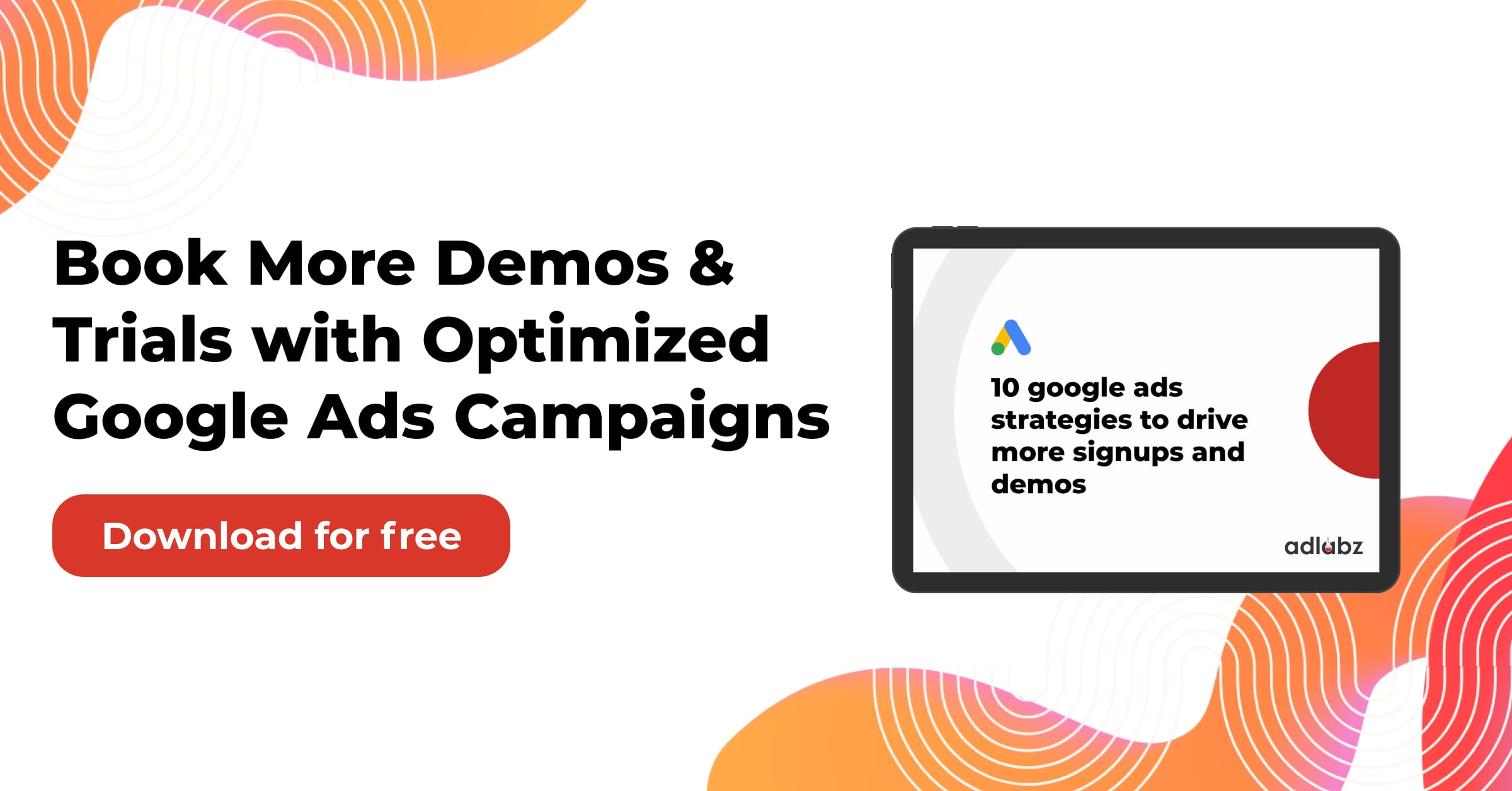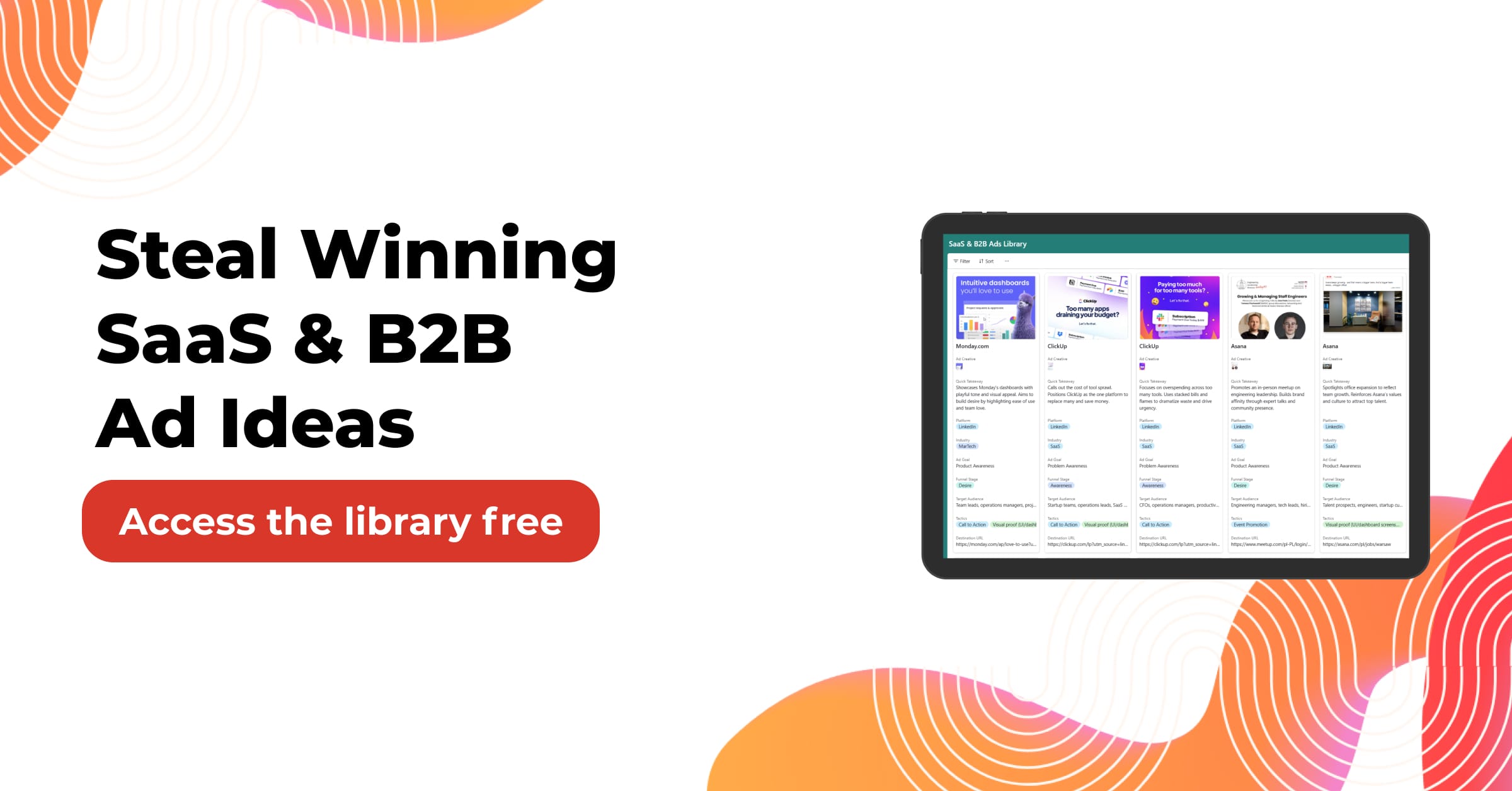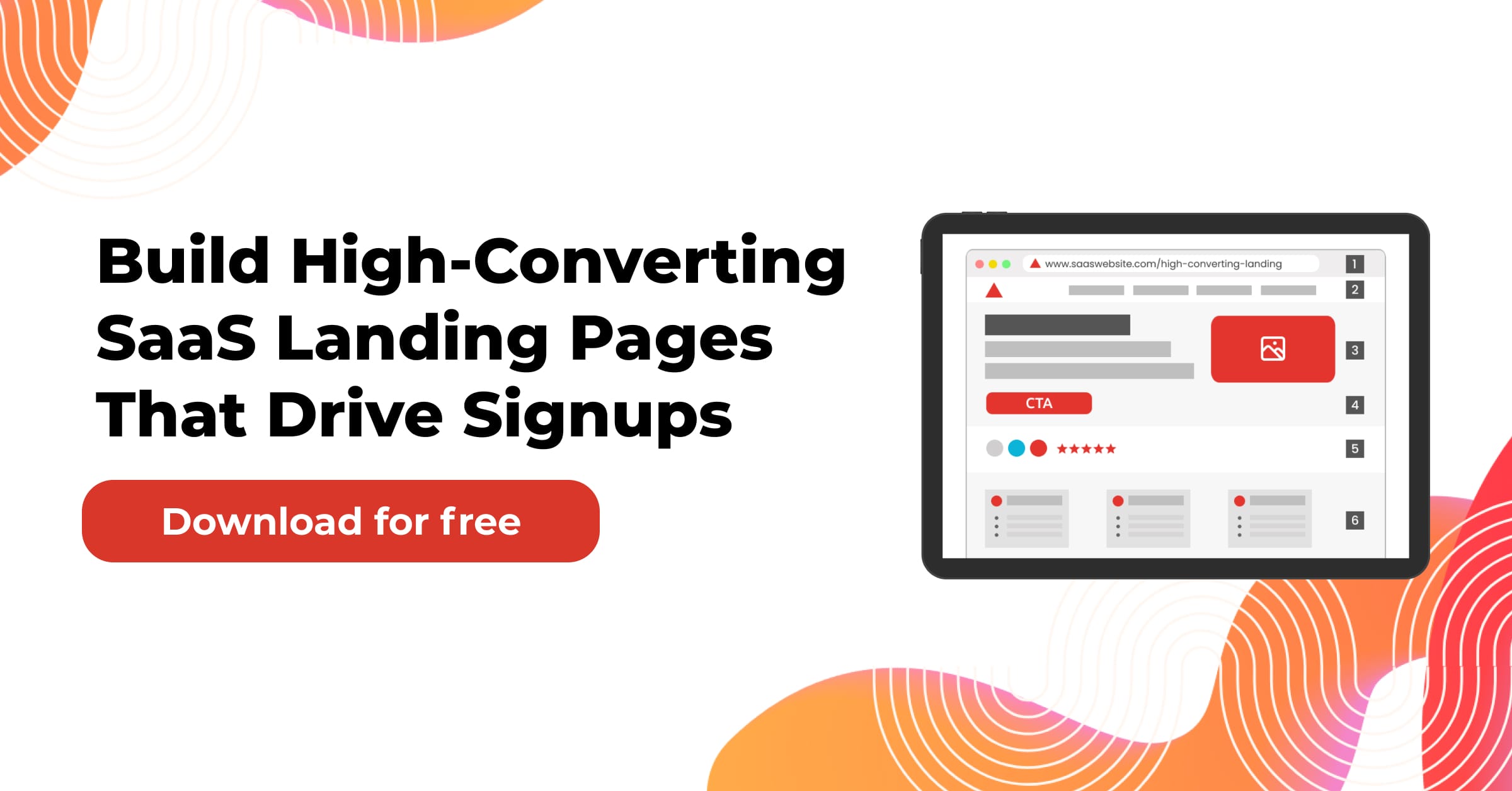What Are SaaS Integrations and Why Do They Matter?
In the SaaS world, integrations serve as the bridge between tools. If your CRM doesn’t communicate with your email platform, or your analytics tool doesn’t pull data from your sales software, you’re stuck in silos.
SaaS integrations automate data flow between apps to eliminate manual work, reduce human error, and streamline operations.
There are two main types:
| Type | Description |
|---|---|
| Native Integrations | Built-in, vendor-supported connections between platforms |
| Third-Party Integrations | Developed by external providers (like Zapier or custom APIs) |
Table of Contents
What Is a Native SaaS Integration?
Native integration is built directly by the SaaS company. It’s packaged with the platform and usually available with a few clicks. Think of Slack’s built-in Zoom, Google Drive, or Asana integrations.
Key Characteristics:
- Built, maintained, and supported by the platform
- Limited to popular services
- Seamless user experience
Example:
Salesforce’s built-in integration with Google Workspace lets users attach emails to leads or contacts directly from Gmail.
What Are Third-Party SaaS Integrations?
Third-party SaaS integrations are connections created by an outside service, often to cover gaps left by native solutions. These can be generic (Zapier, Make, Integrately) or fully custom (via APIs).
Benefits:
- Flexibility to integrate almost any tool
- Custom logic and advanced automation
- Often faster to deploy than custom in-house dev work
Example:
Using Zapier to connect Typeform with Notion, so every new survey response creates a database entry.
When Should You Use Native Integrations?
Use native integrations when:
- You’re using two mainstream platforms (e.g., Slack + Google Drive)
- You want guaranteed vendor support
- You don’t need custom logic or complex workflows
They are especially great for:
- Onboarding teams quickly
- Keeping your tech stack lightweight
- Reducing setup and maintenance
Drawback: Limited flexibility. You can’t tweak or deeply customize logic in most native setups.
When Are Third-Party SaaS Integrations Better?
Third-party SaaS integrations shine when:
- Your tools don’t offer native connections
- You need multiple apps to communicate in a chain
- You want to customize triggers, filters, and logic
They’re ideal for:
- Growth-stage SaaS teams need speed
- Startups with niche tools
- Advanced workflows like lead scoring or multi-platform syncing
Example Use Case:
Send Slack alerts for Stripe chargebacks only when a customer’s MRR > $500, using Make.com.
What Are the Cost Differences Between Native and Third-Party Integrations?
| Cost Factor | Native Integrations | Third-Party SaaS Integrations |
|---|---|---|
| Platform Cost | Often included in base plan | May require paid connectors (Zapier, etc.) |
| Maintenance | Handled by the platform | Your team or third-party tool must maintain |
| Scaling Costs | Generally predictable | Can get expensive as volume grows |
| Developer Involvement | Minimal | May need internal or outsourced dev time |
Native is usually more affordable, but only if it covers your use case.
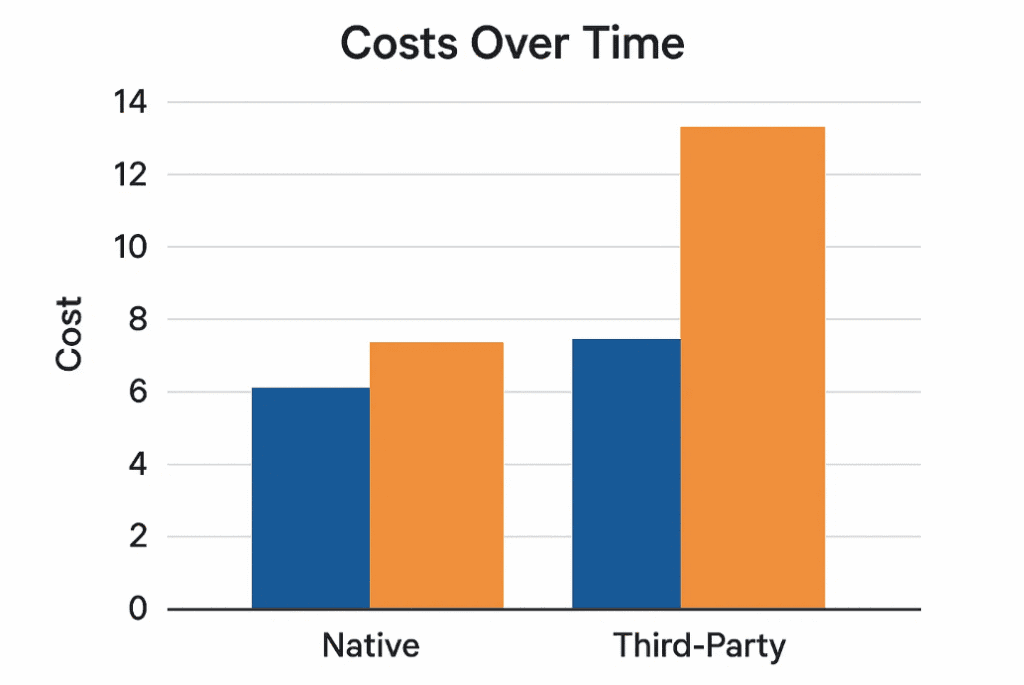
Do Third-Party Integrations Require Coding?
No, not always.
Platforms like Zapier and Make offer no-code and low-code tools. But for advanced use cases, you might:
- Write small JavaScript filters
- Use APIs for data enrichment
- Build webhook-based integrations
So it depends on the complexity of your stack.
Tip: Start with no-code tools, then graduate to APIs as your team matures.
Which Type Offers Better Reliability?
Native integrations are more stable because:
- They’re maintained by the vendor
- Version changes are handled internally
- Support is part of the product plan
Third-party SaaS integrations, while powerful, are more vulnerable to:
- API limits
- Authentication token expires
- App version changes are breaking the flow
If uptime and support are critical, stick with native when available.
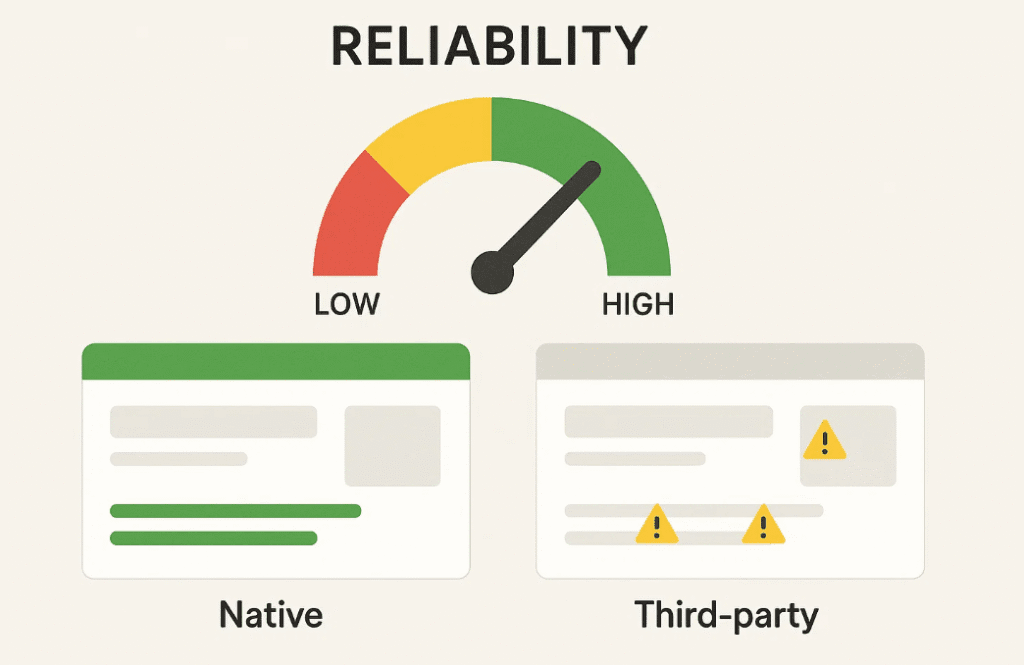
What Are Some Popular Tools for Third-Party SaaS Integrations?
Here are the top platforms for no-code or low-code third-party integrations:
| Tool | Strength | Typical Use Case |
|---|---|---|
| Zapier | Simple 1-to-1 and multi-step flows | Marketing, CRM, email automations |
| Make (Integromat) | Advanced logic, visual mapping | SaaS workflows, data sync, multi-app chains |
| Tray.io | Enterprise-grade integration | API-heavy enterprise use cases |
| Workato | Scalable business automation | Finance, HR, sales operations |
Image Suggestion:
A branded collage of these tools with arrows pointing to app logos like Slack, Airtable, and HubSpot.
How Do Third-Party SaaS Integrations Handle Security?
Security varies based on the provider. Key things to consider:
- OAuth 2.0 or token-based authentication?
- Data encryption during transmission and at rest?
- Does the tool have SOC 2, GDPR, or HIPAA compliance?
Best Practice: Always review the security docs and privacy policy before connecting.
Example:
Zapier is SOC 2 Type II certified and supports 2FA. But if you build custom API integrations, you’re fully responsible for security.

Can I Mix Native and Third-Party Integrations?
Yes—and most modern SaaS teams do exactly that.
Hybrid Approach:
- Use native where available (e.g., Gmail + Slack)
- Use a third-party for custom or unsupported workflows
This gives you the best of both worlds: reliability + flexibility.
Example:
Use HubSpot’s native Google Ads integration for lead tracking, and a third-party tool to sync HubSpot leads to a data warehouse like BigQuery.
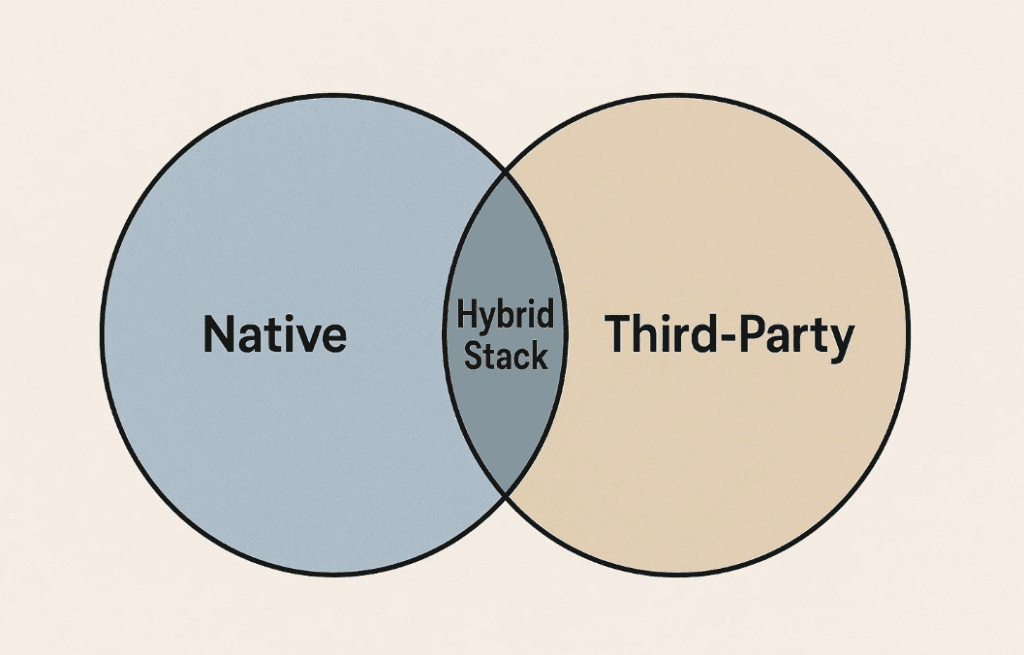
Are Custom API Integrations Better Than Third-Party Tools
Custom APIs are the most powerful—but also the most complex.
| Factor | Custom APIs | Third-Party Tools |
|---|---|---|
| Flexibility | Unlimited | Limited by platform features |
| Cost | High dev and maintenance | Monthly tool fees |
| Time to deploy | Weeks | Hours |
| Maintenance burden | Yours | Platform |
Go custom when:
- You need high-performance data sync
- Your workflows exceed third-party limits
- Security and control are top priorities
Otherwise, third-party tools get the job done faster and cheaper.
What Are the Risks of Using Only One Integration Type?
Going all-in on native limits flexibility. You may hit walls if your stack grows.
Going all-in on third-party raises risks of:
- Workflow failures
- App deprecations
- Unexpected costs
Balance is key. Assess your:
- Team’s technical capacity
- Security posture
- Workflow complexity
Then mix accordingly.
Real-World Case Study: Native vs Third-Party SaaS Integrations in Action
Let’s look at a mid-stage SaaS company, AcmeMetrics, that offers a freemium analytics platform for startups.
Scenario
AcmeMetrics uses:
- HubSpot for CRM
- Stripe for payments
- Slack for internal communication
- BigQuery for advanced analytics
Initially, they used native integrations:
- HubSpot → Stripe (native)
- HubSpot → Slack (native)
The Problem
The team wanted to:
- Send Slack alerts when a new customer churns in Stripe
- Update their data warehouse in BigQuery with churn reasons
- Send a follow-up email from HubSpot after 24 hours
Native integrations couldn’t handle this 3-part logic chain.
The Solution: Third-Party SaaS Integration
They set up a flow in Make.com:
- Trigger: Stripe detects cancellation
- Conditional filter: Only paying users
- Send Slack alert
- Push data to BigQuery
- Delay 24 hours → Send follow-up via HubSpot API
Result:
- Reduced manual tracking by 90%
- Recovered 15% of churned customers with timely follow-up
- Saved 6 hours/week in support team effort
Common Mistakes When Choosing Integration Methods
Too many SaaS teams rush into integrations without a clear plan. Here are the key mistakes to avoid:
1. Assuming Native Is Always “Better”
Native integrations aren’t necessarily best—they’re just easier. They often lack flexibility or deep workflow capabilities.
2. Overengineering with Custom APIs
You don’t always need a custom-built integration. Many use cases are achievable with platforms like Zapier or Workato.
3. Ignoring API Limits and Costs
With third-party SaaS integrations, API limits (like on Google Sheets or HubSpot) can break your flows.
Tip: Always check rate limits before building automations.
4. Skipping Monitoring and Logging
Third-party integrations fail silently if not monitored. Always include error logging, fallback actions, or alerting.
Watch this: https://www.youtube.com/shorts/YOpC2AKYgOs
Integration Decision Checklist: Native or Third-Party?
Use this quick checklist to decide the right integration approach:
| Question | Go Native If… | Go Third-Party If… |
|---|---|---|
| Are both tools popular platforms? | Yes | No |
| Do you need custom logic, filters, or delays? | No | Yes |
| Is developer support available internally? | No | Yes |
| Are reliability and vendor support critical? | Yes | No |
| Do you need rapid deployment? | Yes | Yes (for no-code tools like Zapier) |
| Is your data sensitive or regulated? | Prefer native or custom API with security audits | Use compliant third-party with care |

FAQ: Third-Party SaaS Integrations
1. Are third-party integrations safe for sensitive data?
Yes—if the tool is compliant (e.g., SOC 2, HIPAA, GDPR) and utilizes secure authentication (e.g., OAuth). Always review the provider’s security documentation.
2. Can I use third-party tools in regulated industries?
You can—but your compliance team should vet the tools. Consider data flow, encryption, and storage jurisdictions.
3. What happens if the third-party tool goes down?
Your workflow will fail or be delayed. This is why error logging and fallback actions are crucial.
4. What if I need to scale later?
Most third-party platforms offer tiered pricing. Watch out for volume-based costs and explore platform APIs for custom builds when needed.
5. Which is faster to implement: native or third-party?
For simple use cases, native is fastest. For custom workflows, third-party tools offer faster setup than building APIs from scratch.
Wrapping Up: Which Integration Path Fits You?
Here’s the truth: most SaaS companies eventually need both.
Start with native integrations to get quick wins.
Then, adopt third-party SaaS integrations as your workflows evolve.
The right integration strategy helps you:
- Move faster without more headcount
- Deliver better customer experiences
- Free up your team for high-value work
One Final Thought:
Don’t just connect tools. Design flows that support business outcomes.
You might also be interested:



